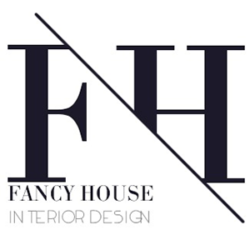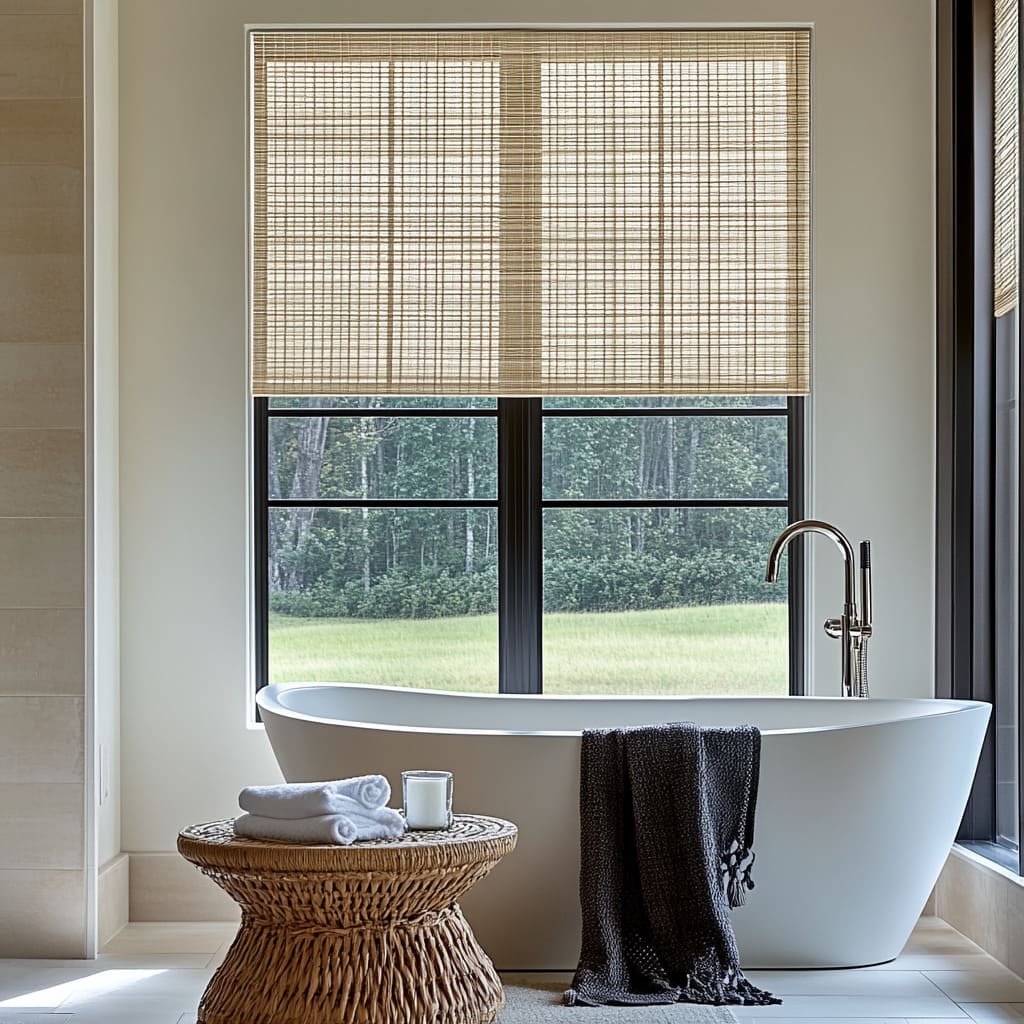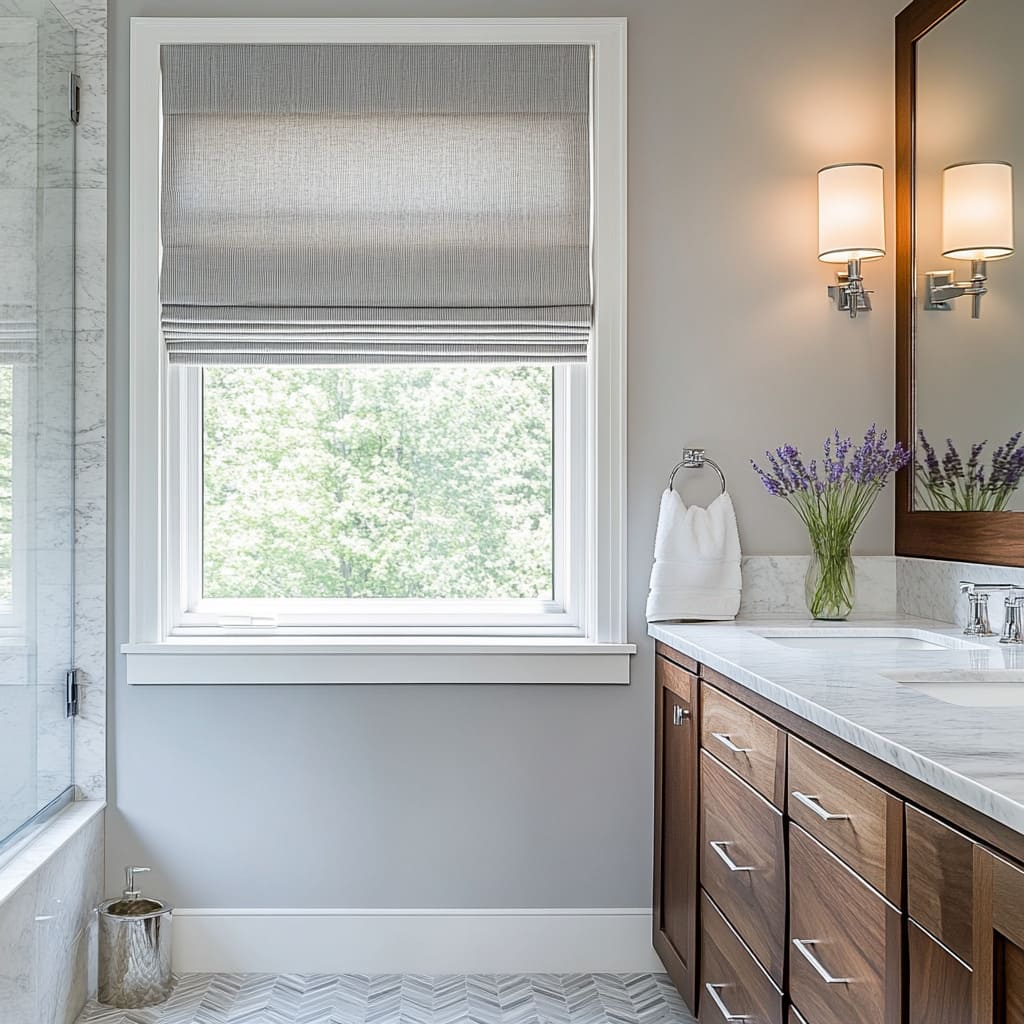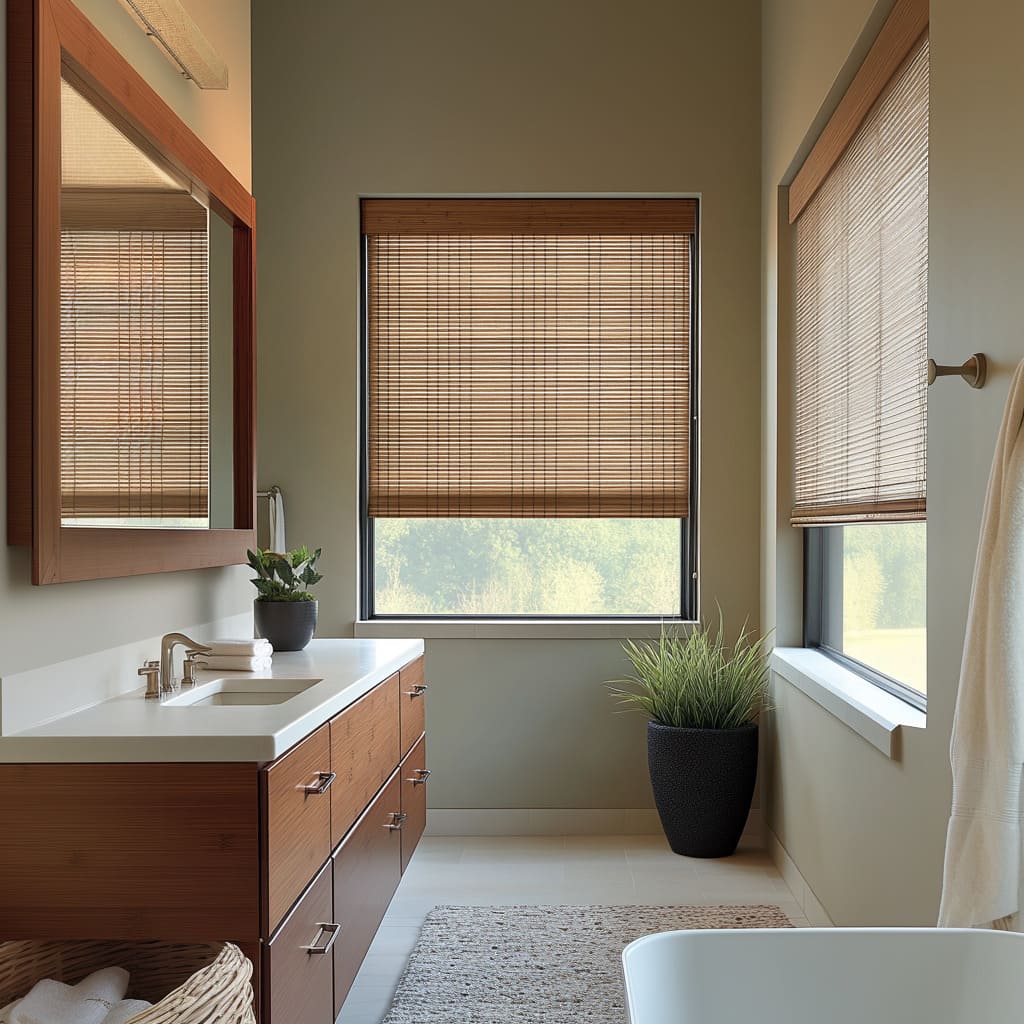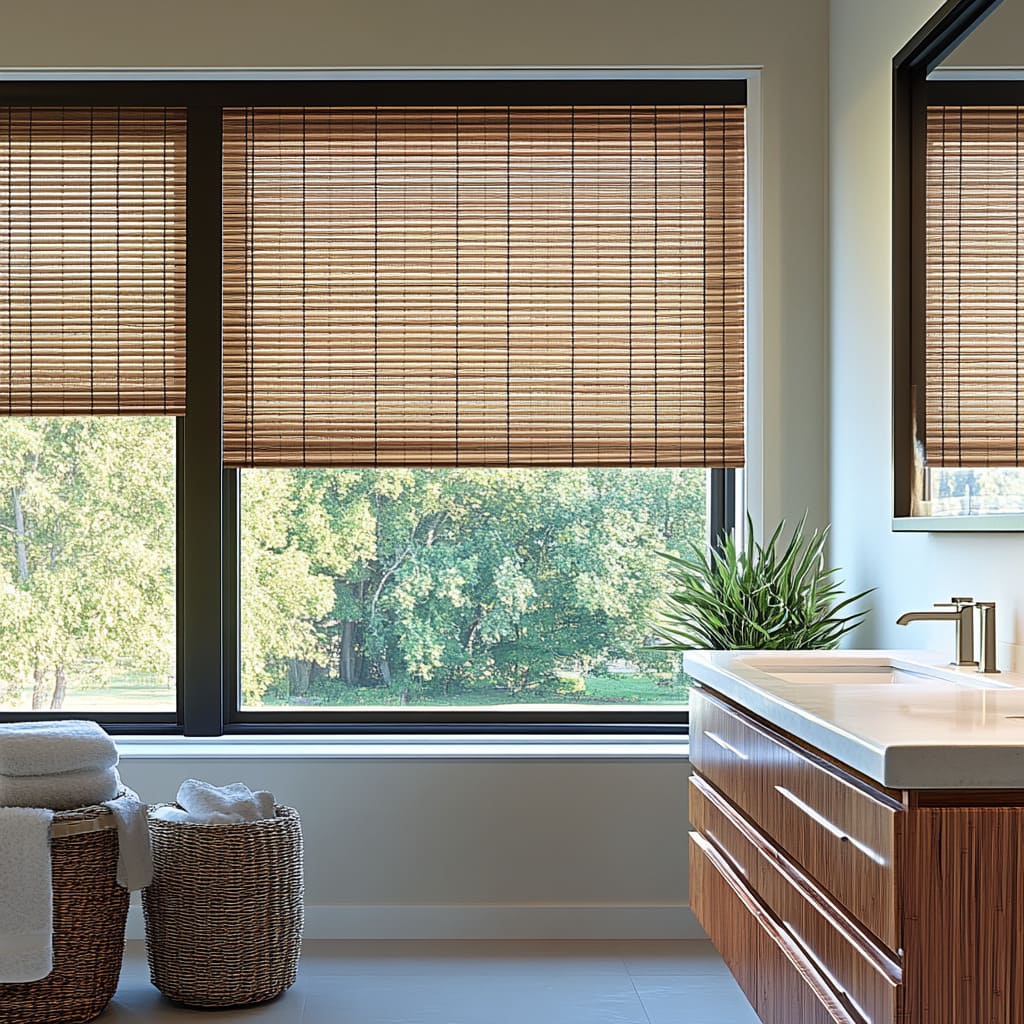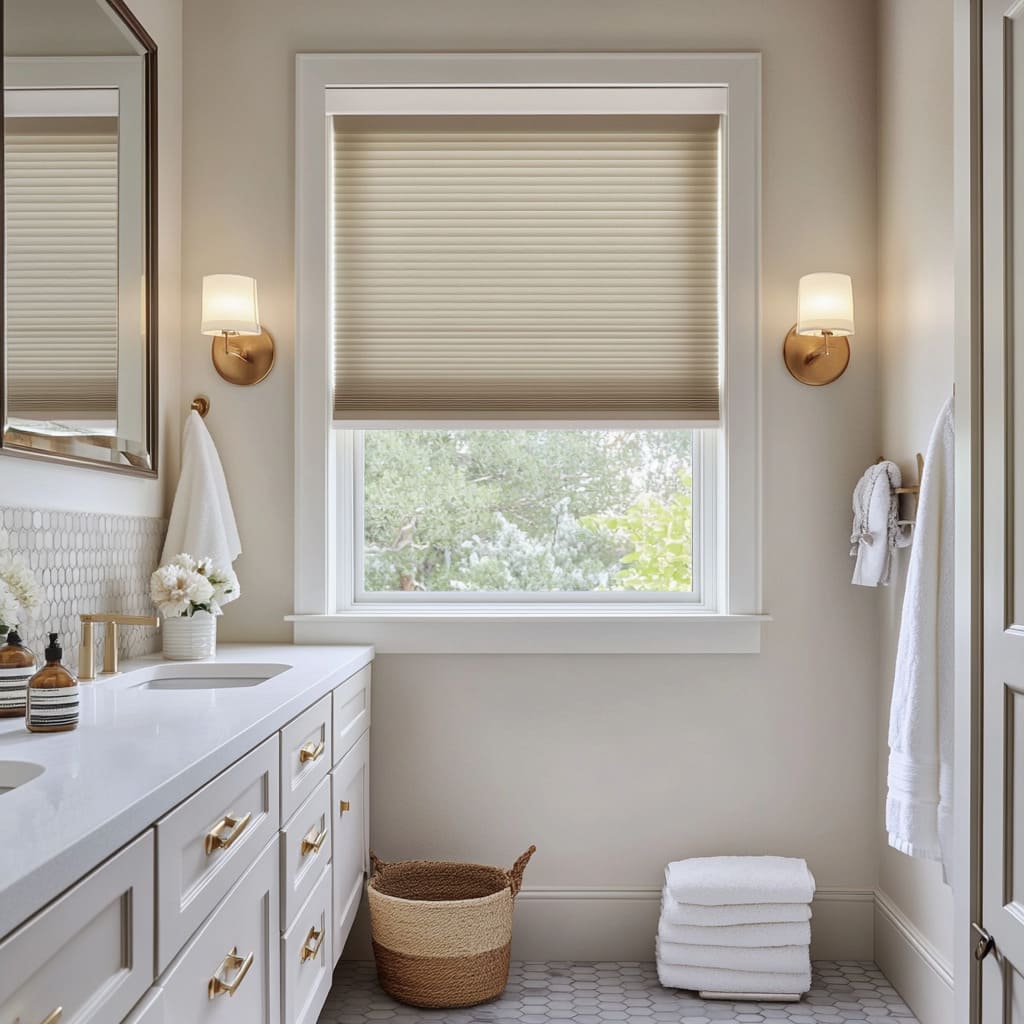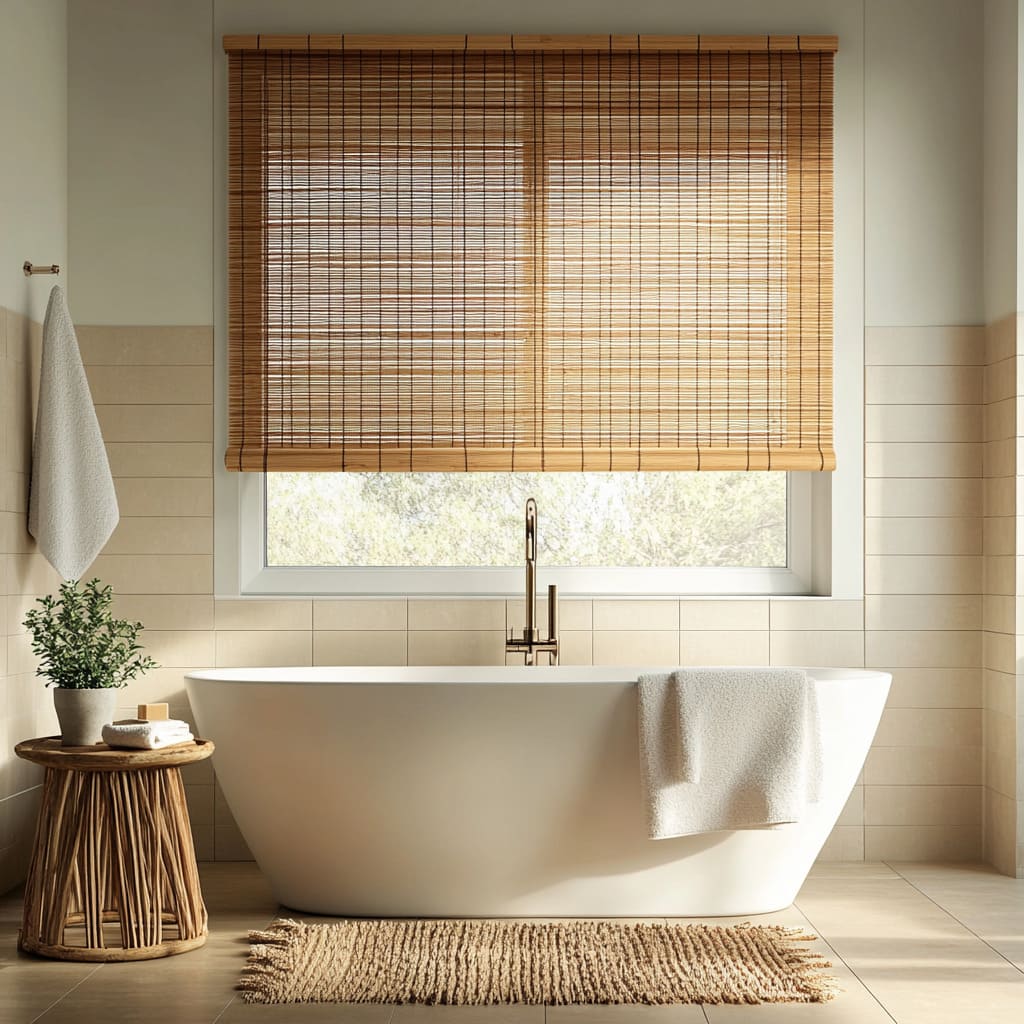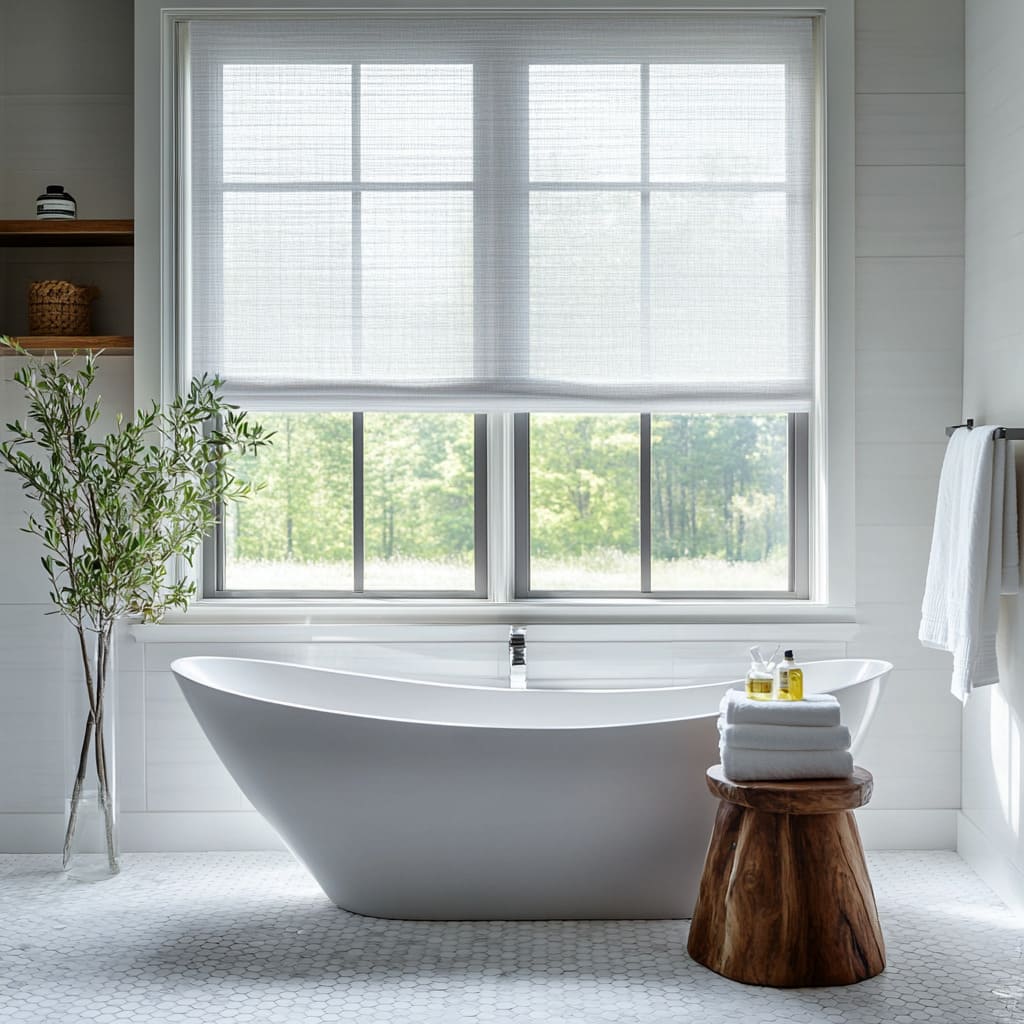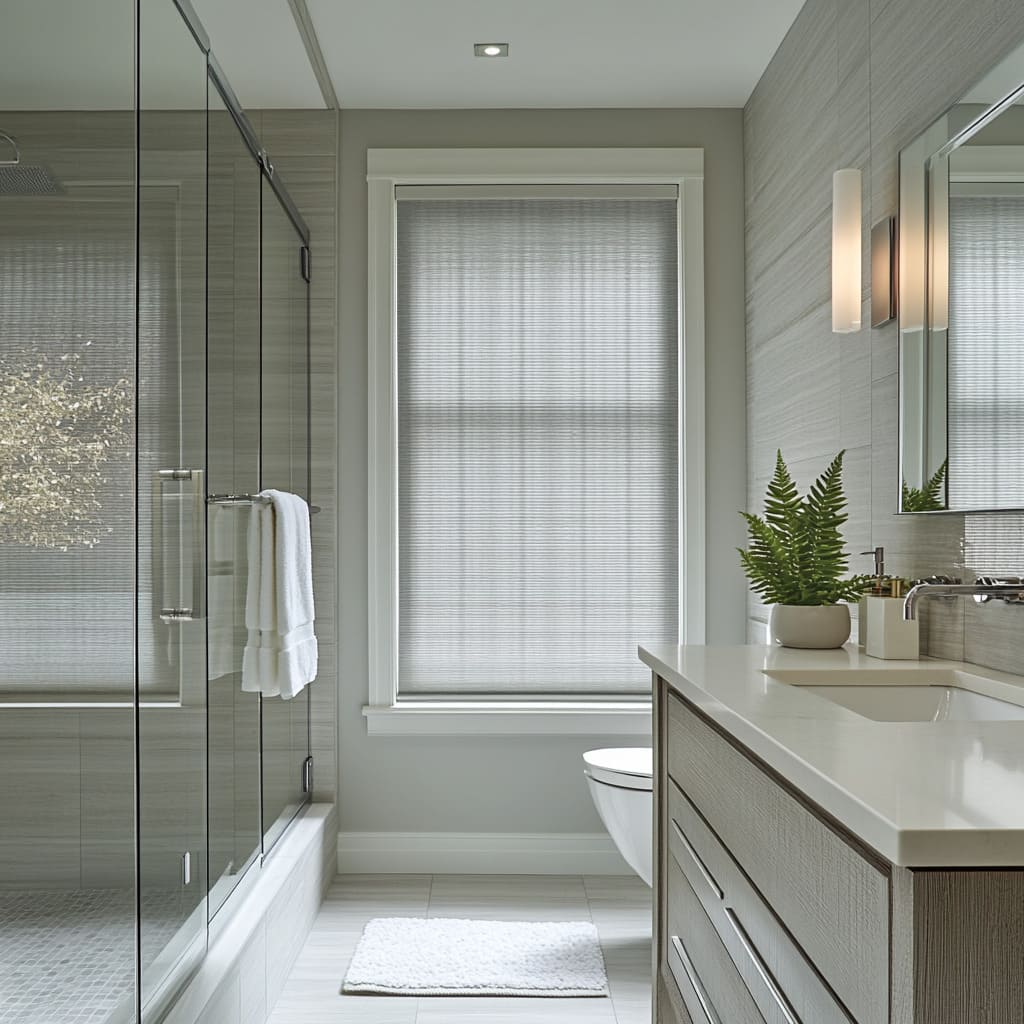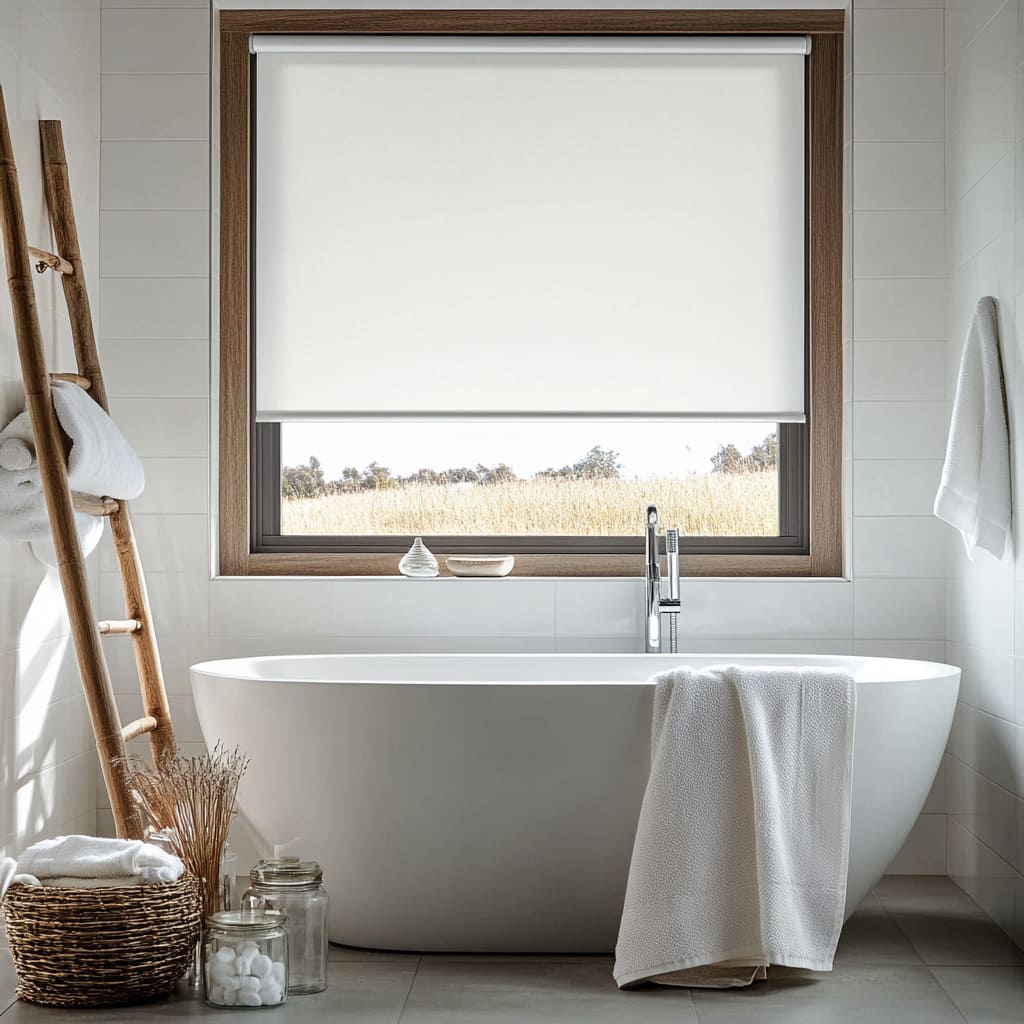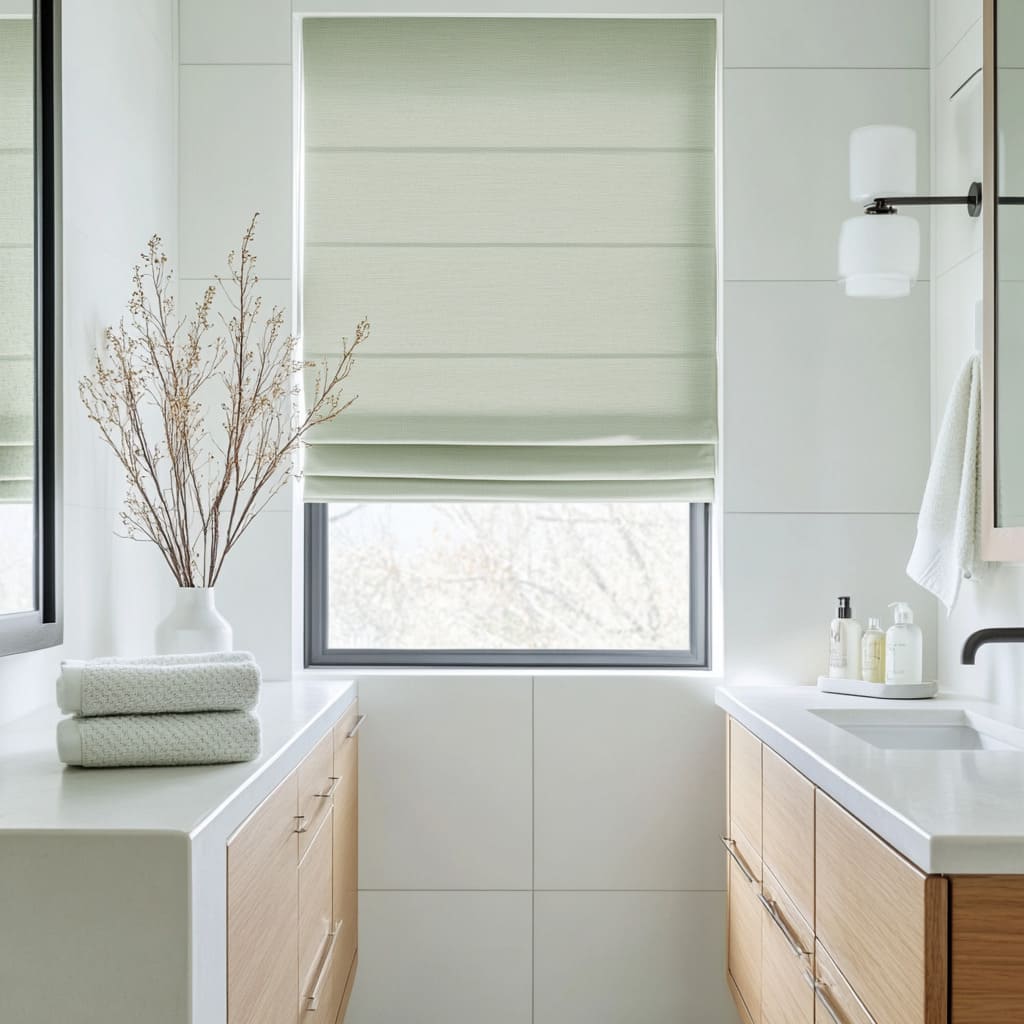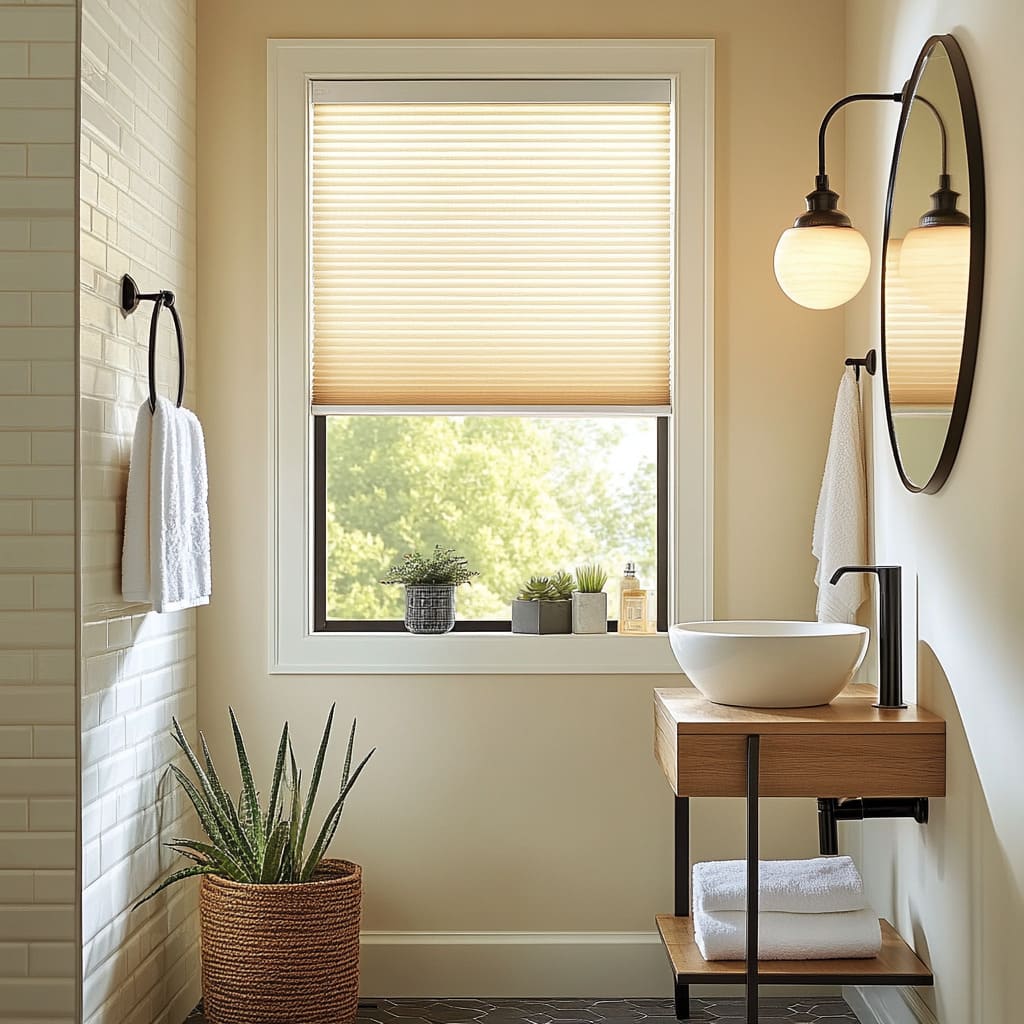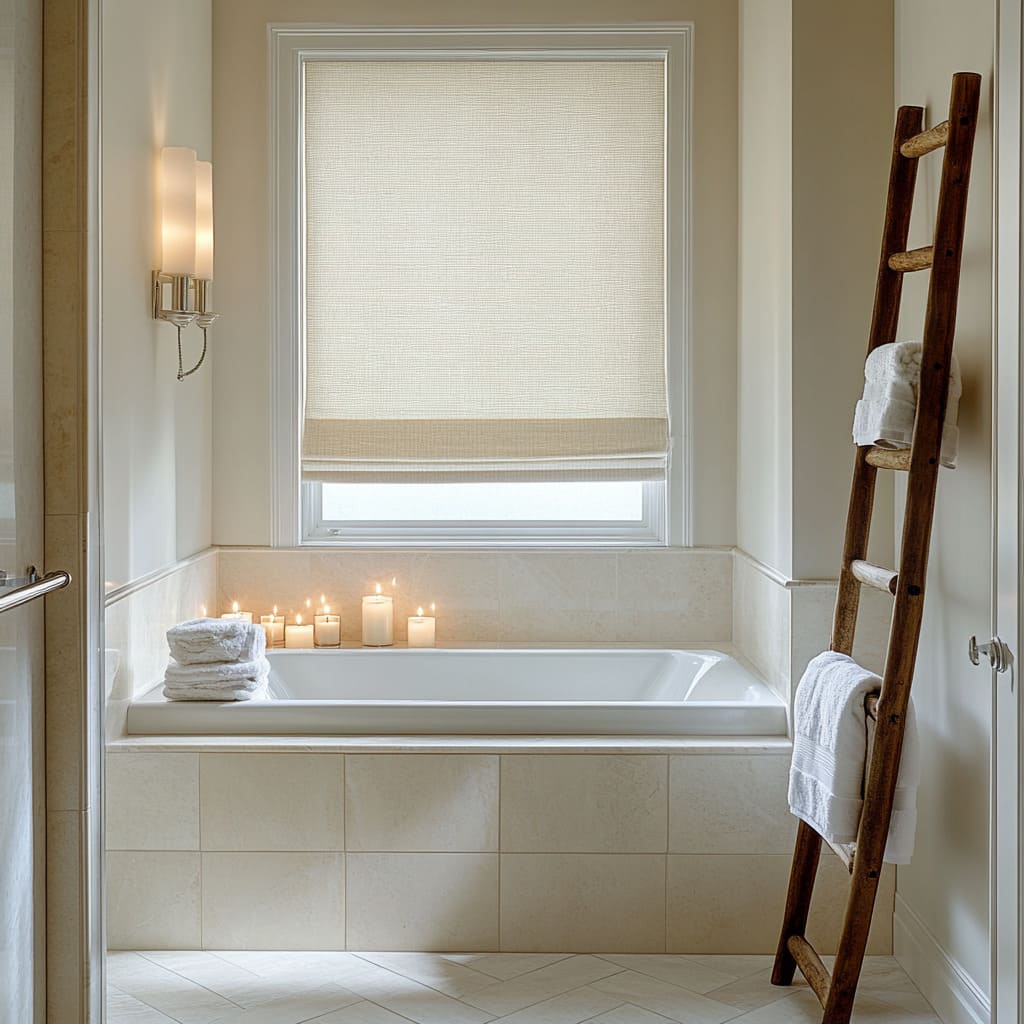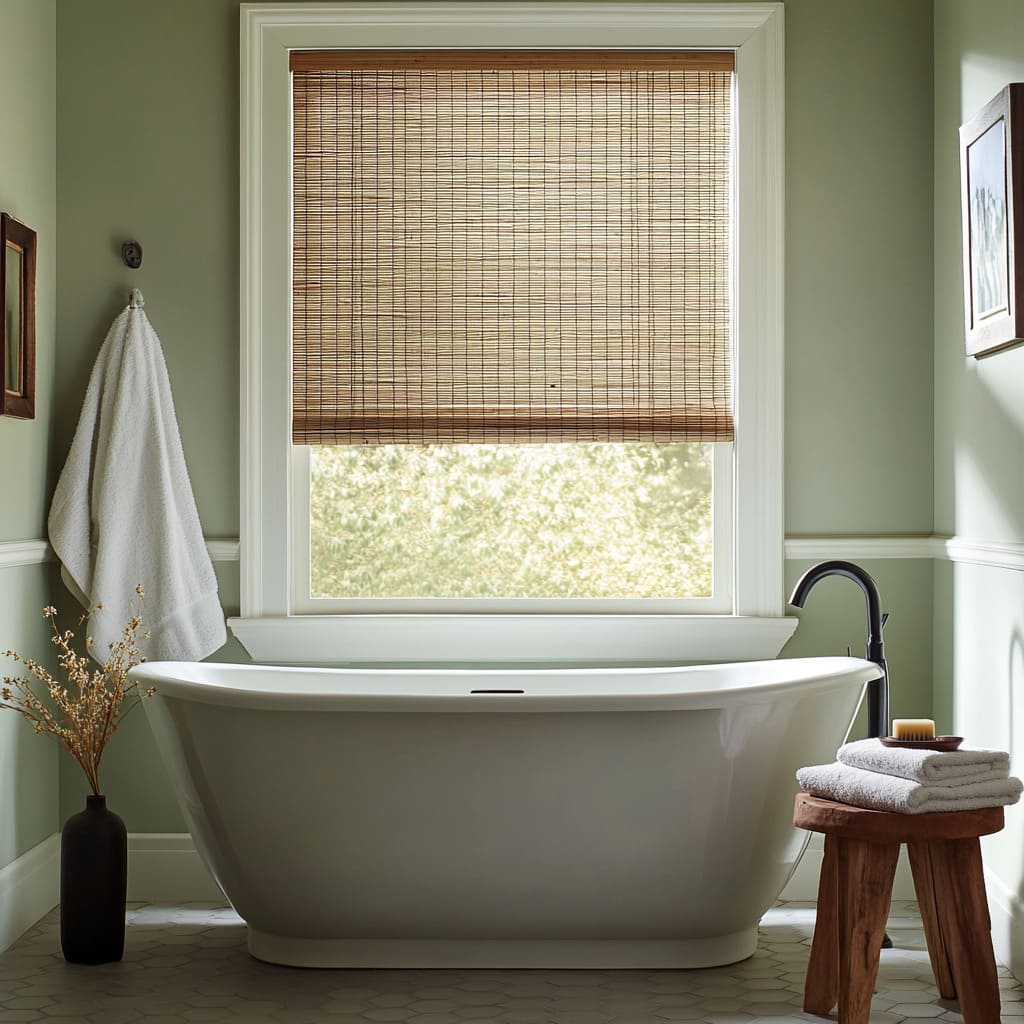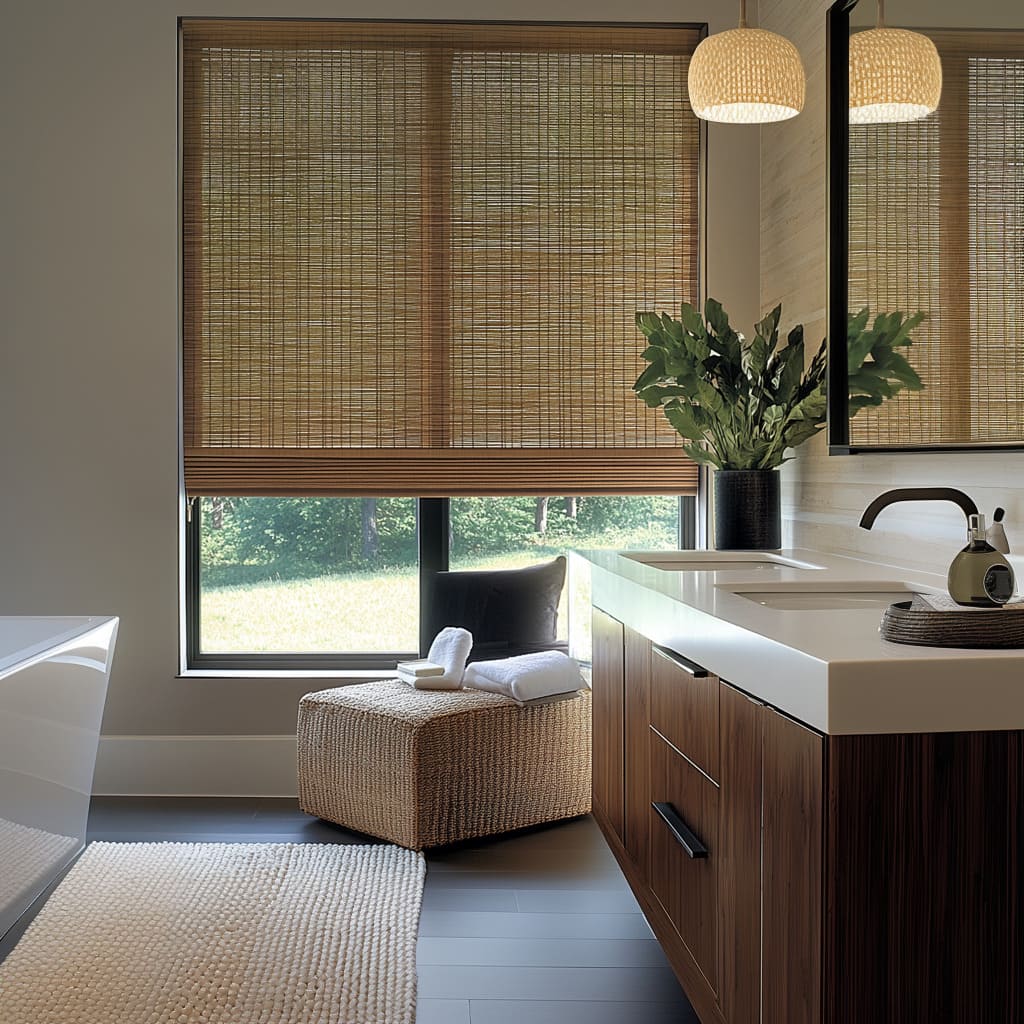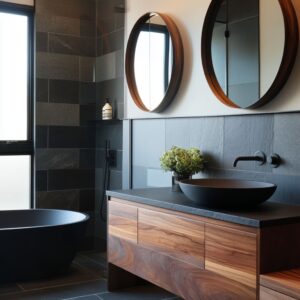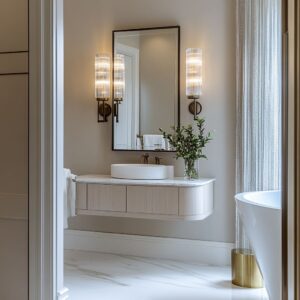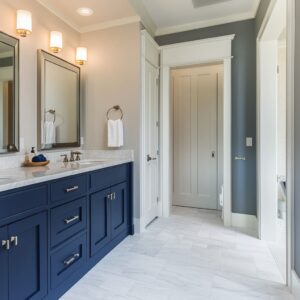Choosing the right bathroom window blinds ideas can completely transform the look and feel of your space. Whether you’re aiming for a sleek and modern finish or a warm and natural ambiance, blinds play a crucial role in balancing privacy, light control, and style.
Bathrooms are unique spaces with specific demands—humidity, varying light levels, and the need for a clean, cohesive design mean that your choice of blinds must be both practical and visually appealing.
In this article, we’ll explore how different materials, textures, and designs can enhance your bathroom while meeting functional requirements. From layered treatments for large windows to moisture-resistant options for high-humidity areas, you’ll find creative solutions suited to any style preference or layout.
Let’s dive into the key considerations to help you create a bathroom that’s both stunning and functional.
The Influence of Texture and Weave
Textured bathroom blinds ideas can transform the feel of your space by playing with light and adding depth. Materials like bamboo, woven wood, or linen bring natural warmth and character, subtly shaping how sunlight filters into the room.
These textures aren’t just visually appealing—they interact with light to create soft patterns and gentle contrasts, making hard surfaces like tiles and ceramics feel more inviting. Adding texture to your bathroom blinds introduces a dynamic element that breaks up large stretches of monotone tiles or smooth finishes.
For example, woven wood blinds paired with rattan chairs or wooden accents can enhance a spa-like vibe. The interplay of materials creates a harmonious balance, adding richness without overcrowding the space.
However, natural fibers require planning—ensure the blinds are moisture-resistant or treated to withstand bathroom humidity, especially in areas with limited ventilation.
Small textural differences can have a surprisingly big impact. In compact bathrooms, a tightly woven blind can provide an understated look that complements the space without overpowering it.
On the other hand, larger bathrooms or those with tall windows benefit from more pronounced textures. These bolder weaves add depth and provide a sense of proportion, especially in minimalist settings.
Actionable tip
When selecting blinds, think about how they’ll complement the existing design. For smaller spaces, less is often more—choose textures that don’t compete with other elements.
In expansive bathrooms, consider blinds that introduce an earthy or organic touch to anchor the room’s design. By aligning the texture of your blinds with the overall style, you’ll create a bathroom that feels cohesive and effortlessly stylish.
Balancing Privacy with Daylight
Finding the right balance between privacy and daylight is essential when considering blinds for bathroom window ideas. Bathrooms often need a degree of seclusion, but natural light brings a sense of openness and practicality.
The challenge is creating a space where both needs are met without compromising style or comfort. Bathrooms, especially in urban areas or homes with close neighbors, benefit from blinds that allow light to filter through while shielding the interior from view.
Semi-translucent materials like sheer roller blinds or honeycomb shades are great choices, as they gently diffuse sunlight to brighten the room while ensuring privacy. This combination can make a small bathroom feel more spacious or add a welcoming glow to larger spaces.
Partially transparent blinds are ideal for designs that incorporate nature-inspired elements. For instance, a bathroom with a large window overlooking a garden or greenery can maintain a visual connection with the outdoors while still protecting your privacy.
The filtered light and partial views create a relaxing ambiance, giving the room a sense of openness without exposing it to outside eyes.
Practical suggestion
For larger or taller windows, motorized blinds or top-down/bottom-up cellular shades are excellent options. They offer flexibility, letting you adjust coverage to block visibility from the outside while allowing daylight to pour in from the top.
This tailored control not only improves functionality but also enhances the overall lighting in your bathroom, making the space feel more balanced and thoughtfully designed.
Coordinating with Existing Wood, Metal, and Tile
A bathroom is often a blend of materials—sleek tiles, warm wood tones, and metallic accents. Thoughtfully chosen window treatments for bathrooms can tie these diverse elements together, creating a space that feels cohesive and well-designed.
Blinds that complement the existing finishes in your bathroom help avoid a mismatched look. For example, bamboo blinds can beautifully echo the tones of a wooden vanity or wicker accents, bringing visual harmony to the room.
Similarly, metal fixtures like chrome or brass are great cues for selecting the right blinds. A subtle sheen in the fabric can reflect metallic tones, or a matte finish can soften their shine, ensuring everything feels balanced.
Color and tone coordination play a major role in achieving a unified design. Blinds that closely match wall tiles or cabinetry create a seamless appearance, making the space feel larger and more cohesive.
On the other hand, high-contrast choices, like crisp white blinds in a black-framed window, can transform the window itself into a focal point. This works particularly well in bathrooms with strong geometric features or bold architectural lines.
Helpful advice
Pay attention to the color temperature of your materials. Cool-toned metals like chrome or polished silver pair well with soft gray or white blinds, while warm brass or gold accents are complemented by beige, caramel, or lightly stained wood blinds.
By mirroring these tones in your blinds, you ensure that every element works together, creating a polished and inviting atmosphere.
Proportion and Orientation
The orientation of your blinds plays a subtle but significant role in shaping how your bathroom feels. Whether emphasizing height or width, the direction and layout of your blinds can influence the room’s overall proportions, ensuring a balanced and pleasing appearance.
The choice between vertical or horizontal designs directly impacts how spacious or compact your bathroom appears. For tall, slim windows, roller or Roman blinds are excellent ideas for bathroom window blinds, as their vertical lines can make the room feel taller.
Horizontal options, like Venetian or plantation-style blinds, create a layered look and can widen the perception of space. However, in smaller bathrooms, too many horizontal lines—especially when combined with horizontal tile grout—may feel visually overwhelming.
Repeating patterns, such as those in cellular or pleated shades, can work wonders in aligning with or subtly contrasting against bathroom finishes. For instance, a minimalist bathroom with smooth, uninterrupted tiles can benefit from the textured rhythm of pleated blinds, adding a layer of interest without complicating the design.
These details are especially impactful when paired with neutral tones that echo the overall color scheme.
Practical tip
Before selecting your blinds, take a close look at the lines already present in your bathroom—tile arrangements, cabinetry shapes, or mirror frames. For a harmonious look, match the orientation of your blinds to these features.
Alternatively, if your design feels too linear, switching up the orientation can introduce balance and break the monotony. Thoughtfully chosen blinds won’t just provide light control and privacy—they’ll also enhance the room’s geometry, making your bathroom look thoughtfully put together.
Impact on Acoustics and Insulation
Bathrooms often have hard surfaces like tile, glass, and porcelain that can amplify sound, creating an echoing effect. The right window treatment in bathroom design not only enhances its look but also helps soften acoustics and improve insulation, making the space feel more comfortable and functional.
Bathrooms can become uncomfortably loud due to the reflective nature of their surfaces. Selecting blinds that offer sound-dampening properties helps create a quieter, more relaxing environment.
Insulation is another factor—while not always a primary concern in a bathroom, having blinds that provide thermal regulation can be useful, especially in homes with older windows or in regions with significant temperature fluctuations.
Cellular, or honeycomb, blinds excel in these areas. Their structured design traps air within the cells, reducing sound reverberation and improving temperature control.
This can be especially valuable in bathrooms with large windows or exterior-facing walls where heat or cold can seep through. Natural materials like wood or bamboo blinds also provide mild acoustic buffering and add a stylish, earthy touch, though they lack the insulation efficiency of cellular designs.
If reducing sound is a top priority, combining woven blinds with soft textiles, such as rugs or fabric accents, can further absorb excess noise while maintaining a cohesive design.
Effective hint
If your bathroom has an exterior wall with a large window or is part of an older home, cellular blinds are a practical and stylish solution for both sound control and insulation. For a design-forward approach, look for options that blend well with your existing color scheme and finishes, ensuring the space remains visually appealing while improving comfort.
Complementing Architectural Features
Bathroom blinds can do more than control light and privacy—they can enhance the architectural details of your space, drawing attention to unique window shapes or integrating seamlessly with surrounding features. Thoughtful choices ensure that your window treatments highlight, rather than compete with, the room’s design.
Windows often include defining elements like decorative molding, custom trim, or nearby shelving that should work in harmony with your blinds. Inside-mounted blinds are a great option for showcasing intricate window trims, keeping the frame visible while providing functionality.
If the window edges aren’t a design highlight, an outside-mounted style can visually expand the frame and provide better coverage for privacy or light control.
In minimalist or modern bathrooms, sleek blinds with concealed hardware are ideal for maintaining a streamlined appearance. They integrate effortlessly with clean lines and simple geometric forms.
Conversely, Roman blinds or soft fabric shades pair well with traditional or classic architectural details, introducing a gentle texture that complements ornate molding or other decorative elements. For custom-shaped windows, like arches or circular designs, blinds specifically tailored to the shape can transform them into standout features.
Instead of treating such windows as challenges, a well-fitted shade enhances their uniqueness while providing the same functional benefits as standard blinds.
Handy suggestion
For spaces emphasizing modern aesthetics, look into modern bathroom blinds ideas that use minimal hardware or innovative mounting techniques. These styles are perfect for enhancing architectural symmetry while avoiding visual clutter.
If your bathroom has a mix of traditional and contemporary elements, consider blinds that bridge these styles, ensuring cohesion without sacrificing any standout details.
Small Details that Elevate the Whole Space
Sometimes, it’s the little things that make the biggest difference, and bathroom window covering ideas are no exception. Subtle design choices like the type of hardware or operating mechanism can add both functionality and finesse to your space, taking it from practical to polished.
Details such as cords, wands, or motorized systems not only affect how easy blinds are to use but also influence the overall look. Cordless or motorized blinds are ideal for creating a clean, uncluttered appearance and are especially useful in family bathrooms where safety is a concern.
Matching hardware finishes—like nickel, brass, or matte black—with existing fixtures (think faucets and towel racks) creates a seamless design flow. In smaller bathrooms, where everything is close together, mismatched hardware can stand out and disrupt the harmony.
Bathrooms are high-moisture areas, and hardware that isn’t designed to resist humidity can deteriorate quickly. Choosing rust-proof or specially coated finishes ensures your blinds remain functional and stylish over time.
This attention to material quality is especially important if your blinds are positioned near a shower or bathtub, where they’re exposed to frequent steam and splashes.
Useful advice
When selecting blinds, prioritize options with moisture-resistant hardware. This not only extends their lifespan but also keeps the look fresh and cohesive.
Opt for a finish that ties into the room’s overall aesthetic for a unified feel. Whether you prefer modern minimalism or a more traditional vibe, these thoughtful details will make your bathroom both functional and visually appealing.
Creating a Coordinated Theme
Blinds are more than a practical addition—they’re an opportunity to shape the personality of your bathroom. Choosing window treatments for bathroom windows that align with the room’s overarching theme ensures a harmonious and intentional design, no matter the style.
The right blinds can tie together various elements in the room, reinforcing its character. Whether you’re aiming for a tranquil retreat with natural materials or a sleek, modern look, blinds contribute to this visual narrative.
By repeating textures like bamboo or woven wood across accessories such as baskets or stools, you create an organic connection that unifies the space. On the other hand, crisp roller blinds or Venetian styles can emphasize clean lines, echoing modern tile layouts and sharp-edged fixtures.
Bathrooms often have focal points, like patterned tiles or an artistic bathtub, that demand attention. In such cases, subdued blinds in neutral tones allow those features to shine without visual competition.
Conversely, in minimalist spaces with fewer standout details, textured blinds—such as those with a bold weave or warm wood tones—can become a subtle yet impactful statement, balancing simplicity with depth.
Practical tip:
Take stock of your bathroom’s most striking features and decide whether the blinds should complement or contrast with them. If your design leans toward the natural, materials like bamboo add warmth and continuity.
For more contemporary spaces, focus on sleek finishes and structured designs that seamlessly blend with your bathroom’s clean lines. Either way, choosing blinds thoughtfully ensures they elevate both form and function in your space.
Maintenance and Durability
Bathroom blinds are exposed to constant humidity, steam, and occasional splashes, making durability a key factor in selecting the best window treatment for bathroom spaces. Choosing materials that resist moisture and are easy to clean ensures both longevity and a consistently fresh appearance.
Blinds in a bathroom face unique challenges compared to those in other parts of the home. They must withstand daily moisture exposure without warping, fading, or becoming a breeding ground for mildew.
High-maintenance materials can become a hassle in busy bathrooms, especially those used frequently by families or in shared spaces. Faux-wood and composite blinds offer the beauty of natural wood while avoiding its tendency to warp in high-moisture environments.
Bamboo blinds add a natural charm but require occasional dusting and wiping to maintain their look. Linen or fabric-based Roman blinds, while visually appealing, may absorb moisture over time, leading to mildew if the bathroom isn’t properly ventilated.
Carefully reviewing the care instructions for these materials is crucial to avoid future issues.
Practical tip
For bathrooms with heavy usage, like those featuring daily showers or baths, opt for moisture-resistant materials or synthetic weaves that mimic natural fibers. These options are low-maintenance and designed to handle the wettest conditions without sacrificing style.
Blinds made with durable, easy-to-clean materials ensure that your bathroom remains both functional and visually polished for years to come.
Layering Window Treatments
Sometimes a single solution doesn’t address every need, making layered bathroom blind ideas both practical and visually appealing. By combining different treatments, you can achieve optimal privacy, light control, and style, all tailored to your specific space.
Bathrooms with large windows or scenic views often require more versatile solutions. A sheer or semi-sheer shade can diffuse natural light beautifully while maintaining partial privacy during the day.
Adding a second blackout layer offers full coverage when complete privacy or light blocking is necessary, like in the evenings or early mornings. This flexibility ensures your bathroom is functional at all hours without compromising its look.
Layering also allows you to play with textures and depths, adding dimension to your bathroom design. For instance, pairing bamboo blinds with a sleek interior liner gives you the option of showcasing natural textures while enhancing coverage when needed.
It’s an effective way to balance aesthetics with function, ensuring your bathroom looks polished while meeting your everyday needs.
Practical tip:
When layering, ensure each treatment has its own mounting hardware for smooth and independent operation. This is particularly important in shallow window frames, where too much thickness can interfere with functionality or create a cluttered appearance.
Thoughtful planning and proper installation will make your layered window treatments both stylish and easy to use.
Closing Thoughts
When dressing a bathroom window, the right blinds can go beyond their functional purpose, shaping the atmosphere of the entire space. From textured natural materials that introduce warmth to sleek, minimalist designs that align with modern aesthetics, each choice influences how the room feels and functions.
Blinds are not just about covering windows; they control light, enhance privacy, and complement architectural details, making them an integral part of the design. By considering elements like insulation, moisture resistance, and the interplay between materials, you can ensure your bathroom feels cohesive and thoughtfully arranged.
The balance of textures, colors, and finishes—whether organic or contemporary—helps create an environment that blends practicality with style.
Take time to explore how your chosen blinds align with fixtures, tiles, and the overall color palette. A carefully selected window treatment ties everything together, making your bathroom a space that works seamlessly for both your daily routines and your design vision.
